The Wine
Estate
A thousand years of history
Before producing some of the best rosés in the whole of Provence, La Commanderie de Peyrassol lived through an extraordinary history unlike that of any other estate. Archaeological findings show that human occupation dates back to the beginning of the Iron Age (1,000 years BC).
The Gallo-Roman period has left even more evidence, especially with the remains of an architectural complex with massive walls which must have been used for agricultural purposes. But, undoubtedly, La Commanderie de Peyrassol entered the history books at the beginning of the 13th Century.
In 1204, the Count of Provence, Alphonse II, donated the estate to the Order of the Knights Templar. This is when “Peirasson” became one of the many Templar commanderies in Provence. The life of the soldier-monks was punctuated by prayers, military training, land reclamation, tax collection and welcoming pilgrims on their way to the Holy Land. The 1,000 hectares of arable land, pastures, woodland, and scrubland part of the estate were used for a variety of agricultural purposes. Cereals, vegetables, olive groves, animal rearing… ensured the livelihood of the small community. The vineyard was an integral part of this polyculture. It produced a wine, which was not yet a rosé, traces of which can be found in a parchment dated 1256 kept in Marseille, reporting the sale of “44 mirolles of good frank wine”.
After the suppression of the Order of the Knights Templar, due to the famous trial ordered by Philippe le Bel, the Knights of the Hospital of Saint John were entrusted with the estate.
It was not until 1789 and the confiscation of Church property by the State that the property changed hands.
The Ricard family bought Peyrassol when national property was sold in 1790.
The Ricard family then sold the estate to the Rigord family in 1830.
Having used food producing polyculture since the beginning, the vineyard took over very gradually. The Rigord family passed on the estate from generation to generation until 1967 when Dr Rigord and his wife Françoise inherited it. The time for rosé had not yet come, but Françoise Rigord, “the lady of Peyrassol”, contributed with talent to establishing a reputation for the new Côtes de Provence appellation.
However, the estate needed substantial investment, both for the Château Peyrassol vineyard and the buildings, to be in keeping with its quality standards. Françoise Rigord decided to sell the estate in 2001 to Philippe Austruy, a wine lover, besotted with perfection and respectful of the memories that inhabit this historic estate.
This was the beginning of a new era for La Commanderie de Peyrassol, and the Château Peyrassol vineyard, thanks to the new owner who fell in love with the estate, the landscapes, and its history.
1204
In 1204, the Count of Provence, Alphonse II, donated the estate to the Order of the Knights Templar. This is when “Peirasson” became one of the many Templar commanderies in Provence. The life of the soldier-monks was punctuated by prayers, military training, land reclamation, tax collection and welcoming pilgrims on their way to the Holy Land. The 1,000 hectares of arable land, pastures, woodland, and scrubland part of the estate were used for a variety of agricultural purposes. Cereals, vegetables, olive groves, animal rearing… ensured the livelihood of the small community. The vineyard was an integral part of this polyculture. It produced a wine, which was not yet a rosé, traces of which can be found in a parchment dated 1256 kept in Marseille, reporting the sale of “44 mirolles of good frank wine“.
~~
After the suppression of the Order of the Knights Templar, due to the famous trial ordered by Philippe le Bel, the Knights of the Hospital of Saint John were entrusted with the estate.
1789
It was not until 1789 and the confiscation of Church property by the State that the property changed hands.
1790
The Ricard family bought Peyrassol when national property was sold in 1790.
1830
The Ricard family then sold the estate to the Rigord family in 1830.
Having used food producing polyculture since the beginning, the vineyard took over very gradually. The Rigord family passed on the estate from generation to generation until 1967 when Dr Rigord and his wife Françoise inherited it. The time for rosé had not yet come, but Françoise Rigord, “the lady of Peyrassol”, contributed with talent to establishing a reputation for the new Côtes de Provence appellation.
2001
However, the estate needed substantial investment, both for the Château Peyrassol vineyard and the buildings, to be in keeping with its quality standards. Françoise Rigord decided to sell the estate in 2001 to Philippe Austruy, a wine lover, besotted with perfection and respectful of the memories that inhabit this historic estate.
This was the beginning of a new era for La Commanderie de Peyrassol, and the Château Peyrassol vineyard, thanks to the new owner who fell in love with the estate, the landscapes, and its history.
AN AMAZING TERROIR
All vineyards claim to have a superb terroir. This is the minimum for those who claim to produce wines of excellence and a rosé, like reds or whites, is no exception.
The main characteristic of a terroir is of course the soil, as well as the altitude, the orientation of the plots, the elevation and the topography, the climate characteristics, the air corridor or whether a plot is protected by, for example, a well-oriented hillock, and the presence of water. All these elements contribute to creating conditions that can be favourable, or not, to wine production and can be ideal and unique.


The work done by men and women plays an important role throughout the seasons: from pruning in winter, to working the soil, to the choice of a specific grape variety for a certain plot, to the precise date for the harvest and the search for the desired maturity. Undeniably, the Château Peyrassol vineyard is blessed by nature!
It is situated at an altitude ranging from 220 to 350 metres above sea level. Ideal conditions for a healthy temperature range during the hot summer months. The 850 hectares property is surrounded by the typically southern vegetation. Truffle oaks, white oaks, olive trees and scrubland provide dense natural protection for the vineyard, cultivated following the rules of organic farming. Finally, nestled in the foothills of the Massif des Maures, in a vast natural cirque, it is protected from the harmful humidity brought by the maritime air masses.
The work done by men and women plays an important role throughout the seasons: from pruning in winter, to working the soil, to the choice of a specific grape variety for a certain plot, to the precise date for the harvest and the search for the desired maturity. Undeniably, the Château Peyrassol vineyard is blessed by nature!
It is situated at an altitude ranging from 220 to 350 metres above sea level. Ideal conditions for a healthy temperature range during the hot summer months. The 850 hectares property is surrounded by the typically southern vegetation. Truffle oaks, white oaks, olive trees and scrubland provide dense natural protection for the vineyard, cultivated following the rules of organic farming. Finally, nestled in the foothills of the Massif des Maures, in a vast natural cirque, it is protected from the harmful humidity brought by the maritime air masses.

The vines thrive on a poor and not very acidic soil dating mainly from the Triassic period, comprising limestone marl which is conducive to producing lively wines, and a feature particularly suitable for white and rosé wines. However, there are many nuances in the 92-hectare vineyards: stony and rocky on the hills, deeper and cooler on the plain, with traces of clay in the sinkhole where the enclosed plot lies… One of the first actions Philippe Austruy undertook when he acquired the estate was to surround himself with a team of experts who identified different plots with homogeneous characteristics.
No less than 63 plots were identified, whose cultivation and eventual production is individualised throughout the wine-making process. The ideal grape variety for each plot was then selected or planted. Thirteen different grape varieties are present at Château Peyrassol. Red grape varieties, used for both rosé and red wines, such as Cinsault, Grenache, Tibouren, Mourvèdre, Syraz and Cabernet Sauvignon. White grape varieties such as Rolle, Ugni Blanc or Semillon are of course used for white wines, but also to produce rosé wines.
The vines thrive on a poor and not very acidic soil dating mainly from the Triassic period, comprising limestone marl which is conducive to producing lively wines, and a feature particularly suitable for white and rosé wines. However, there are many nuances in the 92-hectare vineyards: stony and rocky on the hills, deeper and cooler on the plain, with traces of clay in the sinkhole where the enclosed plot lies… One of the first actions Philippe Austruy undertook when he acquired the estate was to surround himself with a team of experts who identified different plots with homogeneous characteristics.
No less than 63 plots were identified, whose cultivation and eventual production is individualised throughout the wine-making process. The ideal grape variety for each plot was then selected or planted. Thirteen different grape varieties are present at Château Peyrassol. Red grape varieties, used for both rosé and red wines, such as Cinsault, Grenache, Tibouren, Mourvèdre, Syraz and Cabernet Sauvignon. White grape varieties such as Rolle, Ugni Blanc or Semillon are of course used for white wines, but also to produce rosé wines.
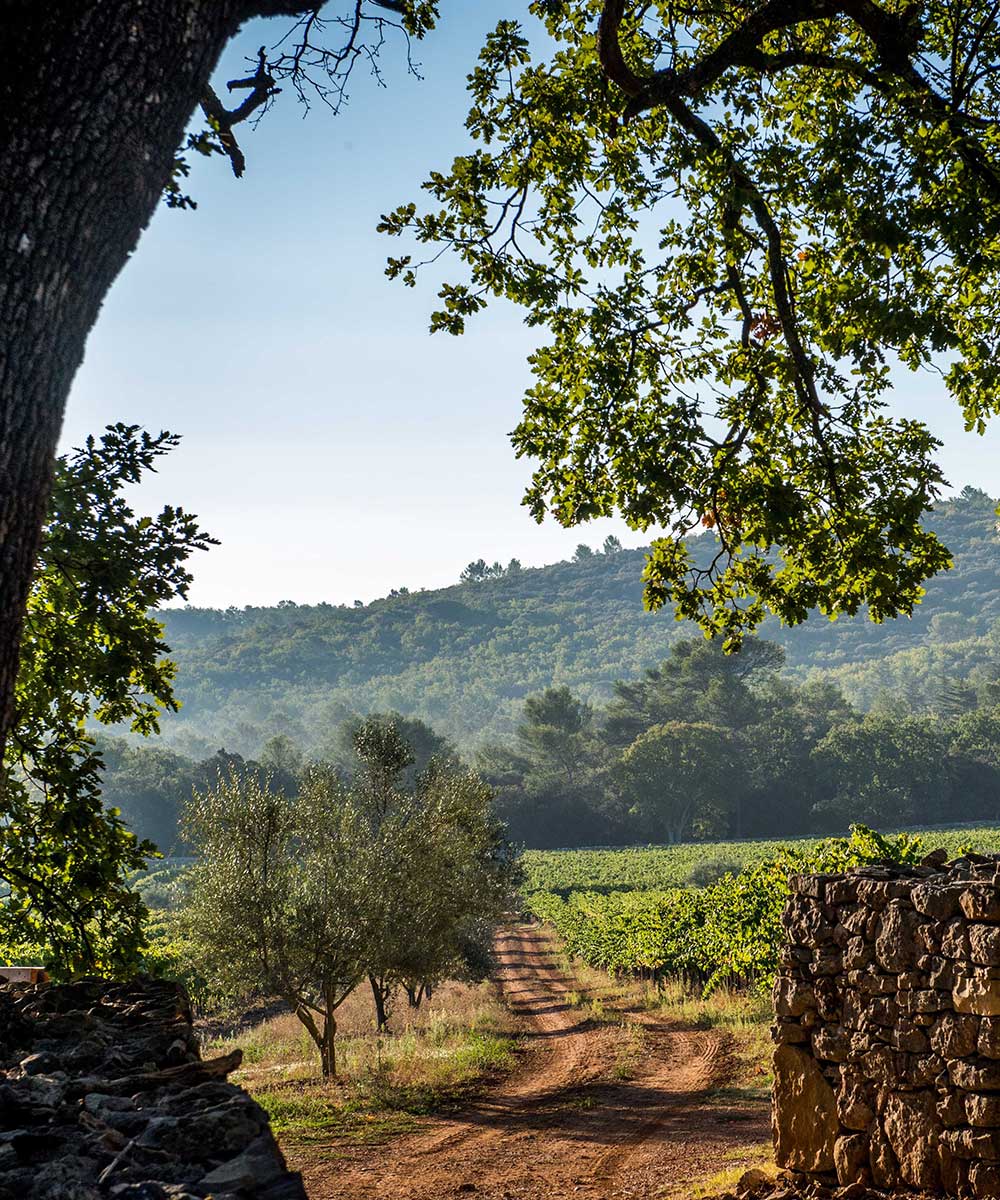
LIKE A GRAND CRU
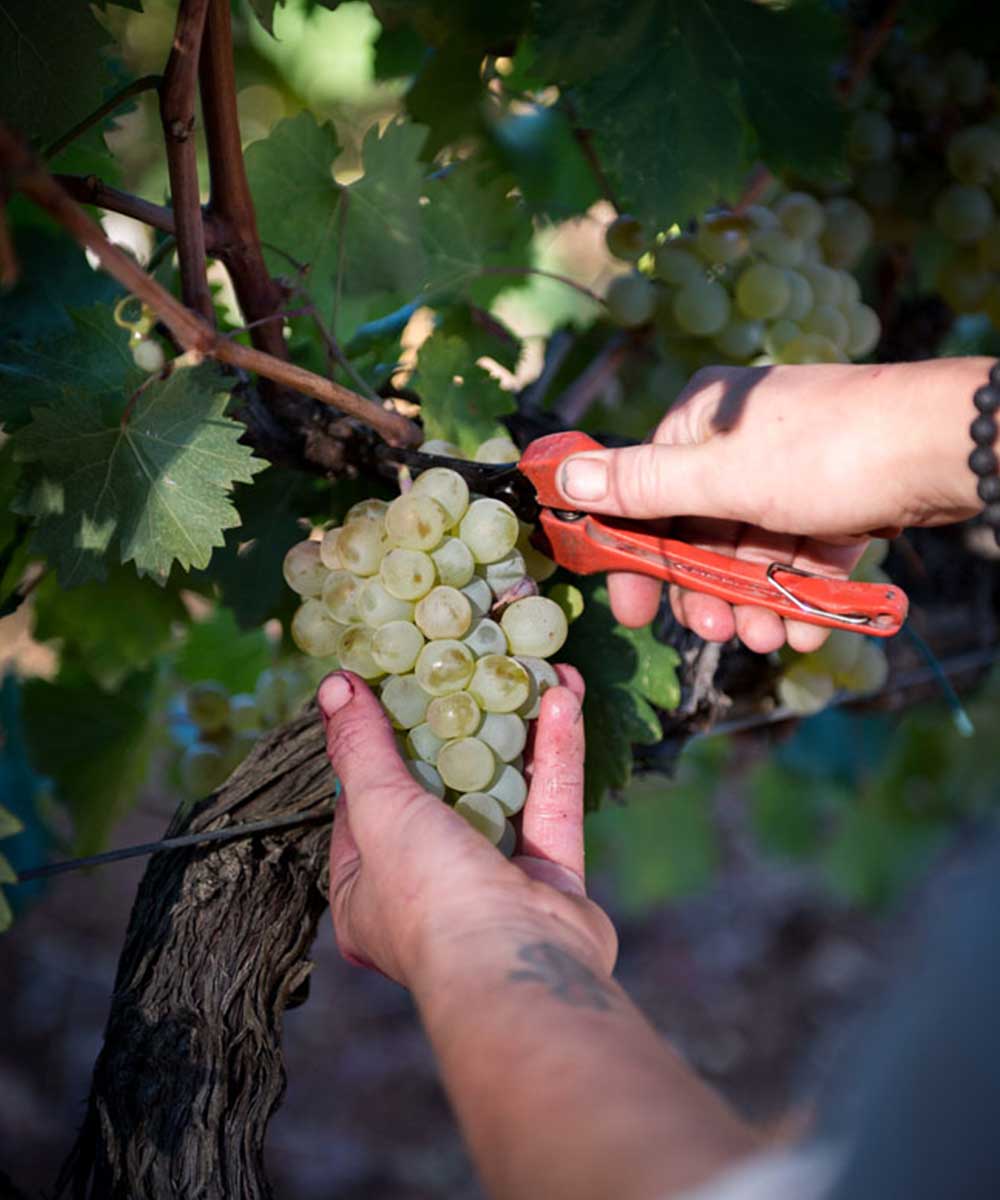
Whatever the plot, the grape variety, the bunch, or grapes… to develop a silky red, a white with a mineral finish or a fresh rosé… the same undivided attention is devoted to work the vineyard.
In accordance with the rules of organic farming, the vineyard is managed like a grand cru. At each stage, the cultivation choice is rigorous.
The yearly cycle in the vineyard is perpetual. The next harvest is prepared tirelessly as soon as the previous harvest comes to an end. A single goal – to obtain the best from each plot to produce a perfect wine, whether red, white, or rosé.
Whatever the plot, the grape variety, the bunch, or grapes… to develop a silky red, a white with a mineral finish or a fresh rosé… the same undivided attention is devoted to work the vineyard.
In accordance with the rules of organic farming, the vineyard is managed like a grand cru. At each stage, the cultivation choice is rigorous.
The yearly cycle in the vineyard is perpetual. The next harvest is prepared tirelessly as soon as the previous harvest comes to an end. A single goal – to obtain the best from each plot to produce a perfect wine, whether red, white, or rosé.

In winter, the vines enter a resting period. This is when pruning begins, a task that is crucial for the future of the harvest.
Let us not forget that the vine is a climber. It is therefore necessary to maintain a balance between its prolific growth and the production of grapes. If the vine is “loaded” with grapes, the berries will be abundant, but smaller and more acidic. The quality of the grapes will therefore be poor. Pruning consists of limiting the number of bunches of grapes that will develop on the vine by selecting the branches that will bear the future buds. This task must be done manually to ensure perfect control of the vine’s growth and takes place throughout the winter, in the wind, cold and bad weather.
This period of vegetative rest is also favourable for planting young vines to replace missing plants and for the installation or repair of the wires that will support the growth of the vines.
Finally, in line with the Château Peyrassol philosophy, to produce respecting nature and the living world, cereals and pulses are sown between the rows during the winter. This favours natural soil loosening, biological activity, and protects against erosion.
Spring arrives and nature awakens. The buds appear and the team, with a view to quality, removes the superfluous buds. To encourage the proper ripening of future grapes, excess vegetation is also pruned. Working the soil and harvesting the greenery complete the effort deployed to ensure that future grapes reach their maximum quality potential.
No chemicals are used in the cultivation methods used on the estate, managed entirely according to strict organic farming standards. Any outbreak of mildew or powdery mildew is monitored very closely and only the curative use of sulphur and copper is allowed.
Summer brings the dry heat of the Mediterranean climate. The deeply rooted Peyrassol vines defy these typical periods of water shortage.
From mid-August onwards, the maturity of the berries is closely monitored. Plot by plot, variety by variety, the grapes are analysed and tasted to assess sugar and acidity, aromas, and tannins…
When the decision is made, the harvest traditionally begins on the sunniest plots. The harvest is manual and at night and mobilises a large team of grape-pickers. Mechanical harvesting allows the pickers to intervene quickly in case of bad weather.
Everything is then done to avoid oxidation and the onset of maceration: small 30 kg crates to avoid crushing the fruit and short journeys to the cellar in double-bottomed trailers. This process is done for reds but also for white and rosé wines. All wines need grapes to be undamaged.
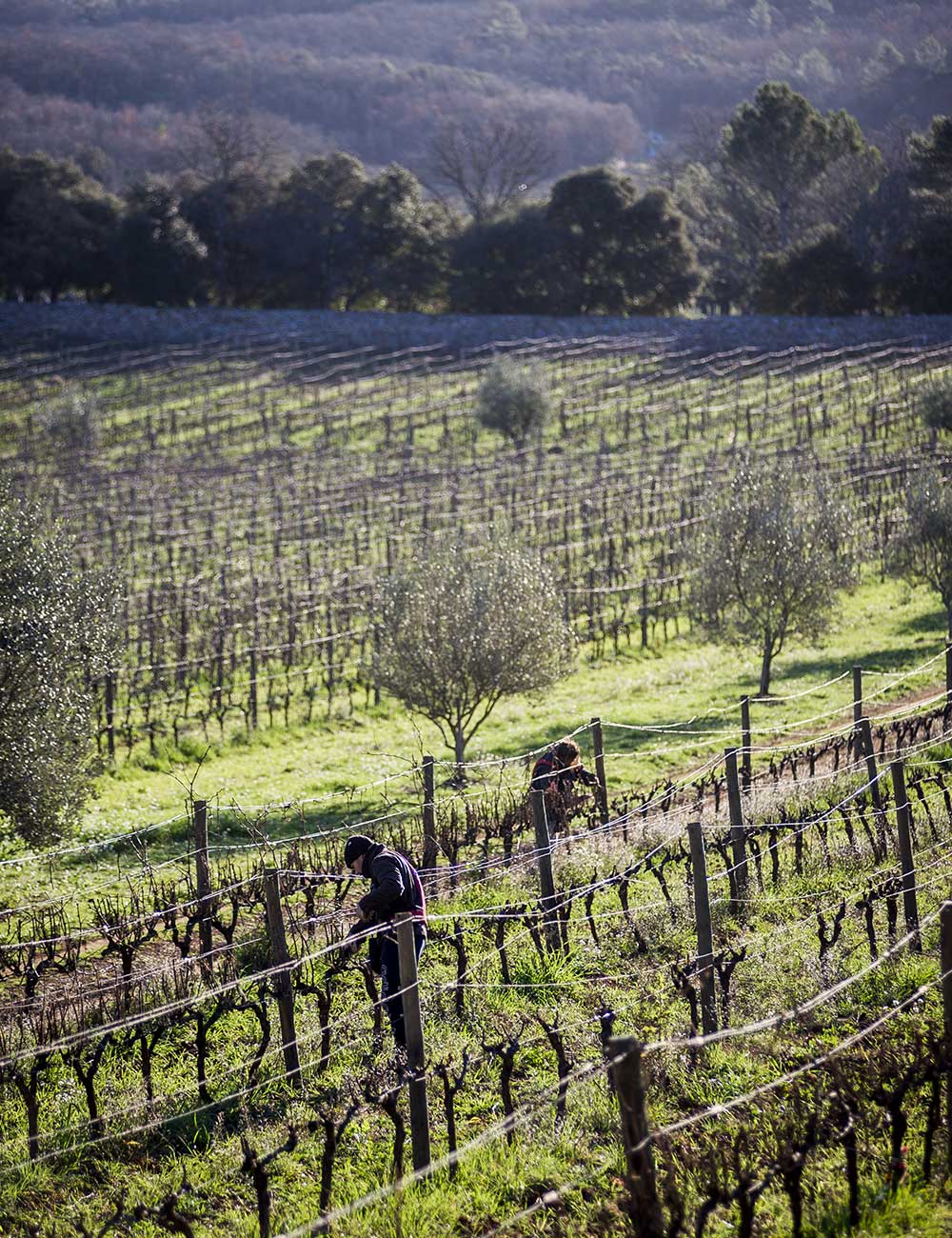
In winter, the vines enter a resting period. This is when pruning begins, a task that is crucial for the future of the harvest.
Let us not forget that the vine is a climber. It is therefore necessary to maintain a balance between its prolific growth and the production of grapes. If the vine is “loaded” with grapes, the berries will be abundant, but smaller and more acidic. The quality of the grapes will therefore be poor. Pruning consists of limiting the number of bunches of grapes that will develop on the vine by selecting the branches that will bear the future buds. This task must be done manually to ensure perfect control of the vine’s growth and takes place throughout the winter, in the wind, cold and bad weather.
This period of vegetative rest is also favourable for planting young vines to replace missing plants and for the installation or repair of the wires that will support the growth of the vines.
Finally, in line with the Château Peyrassol philosophy, to produce respecting nature and the living world, cereals and pulses are sown between the rows during the winter. This favours natural soil loosening, biological activity, and protects against erosion.


Spring arrives and nature awakens. The buds appear and the team, with a view to quality, removes the superfluous buds. To encourage the proper ripening of future grapes, excess vegetation is also pruned. Working the soil and harvesting the greenery complete the effort deployed to ensure that future grapes reach their maximum quality potential.
No chemicals are used in the cultivation methods used on the estate, managed entirely according to strict organic farming standards. Any outbreak of mildew or powdery mildew is monitored very closely and only the curative use of sulphur and copper is allowed.
Summer brings the dry heat of the Mediterranean climate. The deeply rooted Peyrassol vines defy these typical periods of water shortage.
From mid-August onwards, the maturity of the berries is closely monitored. Plot by plot, variety by variety, the grapes are analysed and tasted to assess sugar and acidity, aromas, and tannins…
When the decision is made, the harvest traditionally begins on the sunniest plots. The harvest is manual and at night and mobilises a large team of grape-pickers. Mechanical harvesting allows the pickers to intervene quickly in case of bad weather.
Everything is then done to avoid oxidation and the onset of maceration: small 30 kg crates to avoid crushing the fruit and short journeys to the cellar in double-bottomed trailers. This process is done for reds but also for white and rosé wines. All wines need grapes to be undamaged.
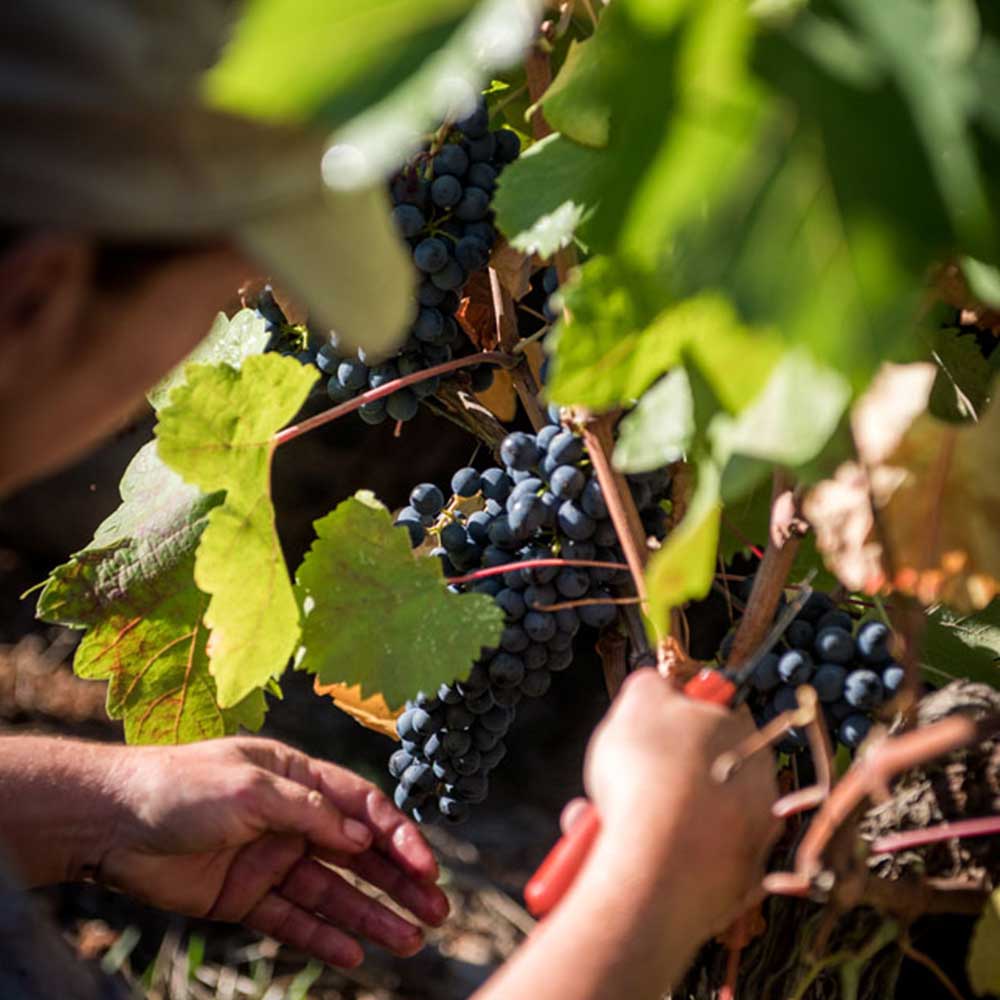
THE SECRETS OF THE CELLAR

A new story then begins in the coolness of the ancestral cellars of Peyrassol.
Making a good wine, a wine with a personality that tells stories of hot clay-limestone soils and hillsides bordered by cork oak forests, clay and limestone, is a much more complex affair than one might imagine. Making a wine with great significance and capable of arousing an emotion… is ultimately an art form.
And at Peyrassol we cultivate the art of wine with passion: velvety reds, fresh rosés, elegant whites which, each year, delight the most demanding wine lovers.
A new story then begins in the coolness of the ancestral cellars of Peyrassol.
Making a good wine, a wine with a personality that tells stories of hot clay-limestone soils and hillsides bordered by cork oak forests, clay and limestone, is a much more complex affair than one might imagine. Making a wine with great significance and capable of arousing an emotion… is ultimately an art form.
And at Peyrassol we cultivate the art of wine with passion: velvety reds, fresh rosés, elegant whites which, each year, delight the most demanding wine lovers.

Our rosé wines
How can we not start with the star of our cellars, the rosé. It is undoubtedly the estate’s largest production but certainly not the easiest. Because making a perfectly balanced rosé wine requires know-how, constant attention and, above all, a sense of timing!
But first we must clarify one point. The juice of red grapes is white. It consists of water, sugar, and acids. It is the skin that contains the colour, aromas, and tannins.
To make a rosé wine by direct pressing, the method used by Château Peyrassol, the grapes are placed in a pneumatic press and pressed for 2 to 4 hours. This is the only time when the juice is in contact with the skins. It then acquires its pinkish colour and aromas.
The juice is then cleared of impurities: this is the settling process. Then the alcoholic fermentation in stainless steel vats begins, at a temperature of between 15 and 18°C.
The juice of the grapes from the same plot is kept in dedicated and identified vats where vinification takes place until the time comes to blend the rosé and white wines.
This is an essential step in Provence, which has made it a marker in the development of Côtes de Provence.
During tasting, each vat asserts its personality and characteristics. Like the nose required by a perfume designer, this palette of aromas, colours, olfactive and taste profiles is the scale on which the cellar master, surrounded by advisors and the owner, will use to create each cuvée.
Several stages and tasting sessions are necessary before obtaining the end result. Two pre-selection sessions in November, then 2 to 3 selection sessions before the final blend. Around the table, Fabien Burani and Pierre Guérin, our consultant for rosé and white wines over the past 20 years, and at times Fouad Essoualeh, the vineyard manager, with Alban Cacaret validate the final choice. It takes almost two months to complete this crucial stage, which also requires a combination of experience, intuition, and a touch of magic.
The rosés then age for a few months before being bottled from February onwards. Generally kept in stainless steel vats, they can also be vinified and then aged in jars, as is the case for the Clos Peyrassol.
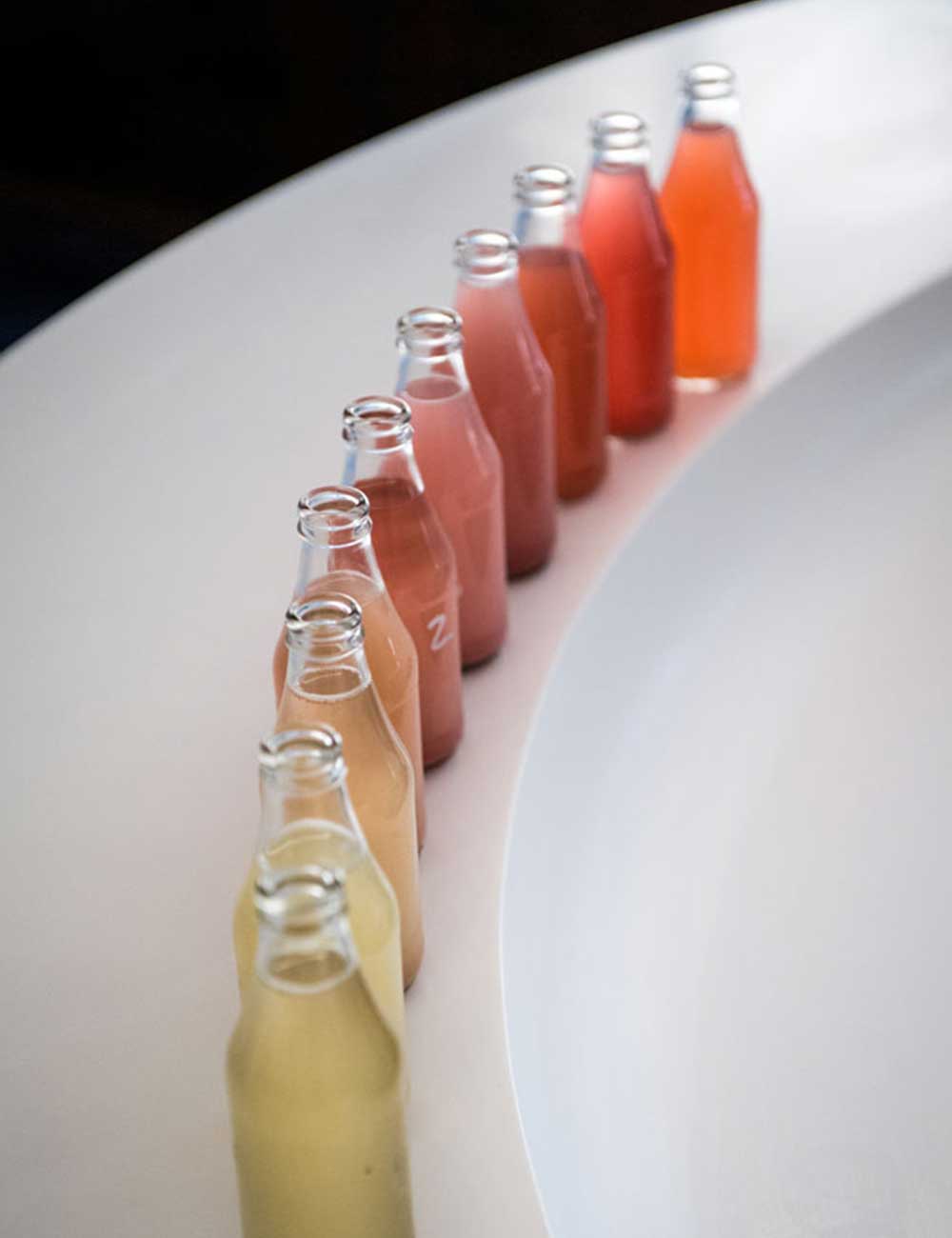
Our white wines
Although they represent only 5% of the estate’s wines, the Peyrassol whites are not treated as a lesser wine. They are made exclusively with our white grape varieties and are therefore ‘Blancs de Blancs’ (whites made from white grapes). They are appreciated for their distinctive personality and finesse.
Before pressing, the grapes are separated from the stalks… but not always: for certain grape varieties, the “whole bunch” is pressed. This is a way of preserving the quality of the juice, protecting it as long as possible from coming into contact with the air by ensuring the grapes are intact until the very last moment.
When the juice and skins have been separated, all the suspended particles are allowed to settle. The clearest part is transferred to another vat, to barrels or to stoneware jars. This process of clarification is called “débourbage”.
Once the juice in the new container is clear, the alcoholic fermentation takes place. The sugar turns into alcohol, the temperature rises during this transformation, and we keep the wine at a low temperature by using heat exchangers. Fermentation takes place between 14° and 18°C to preserve the quality of the aromas.
For a few months after fermentation, the new wine undergoes the ageing process: in stainless steel tanks, in oak barrels and/or, depending on the batch, in stoneware jars. Each container, because of the degree of exposure to air, will have a huge influence on the final taste of our different vintages.
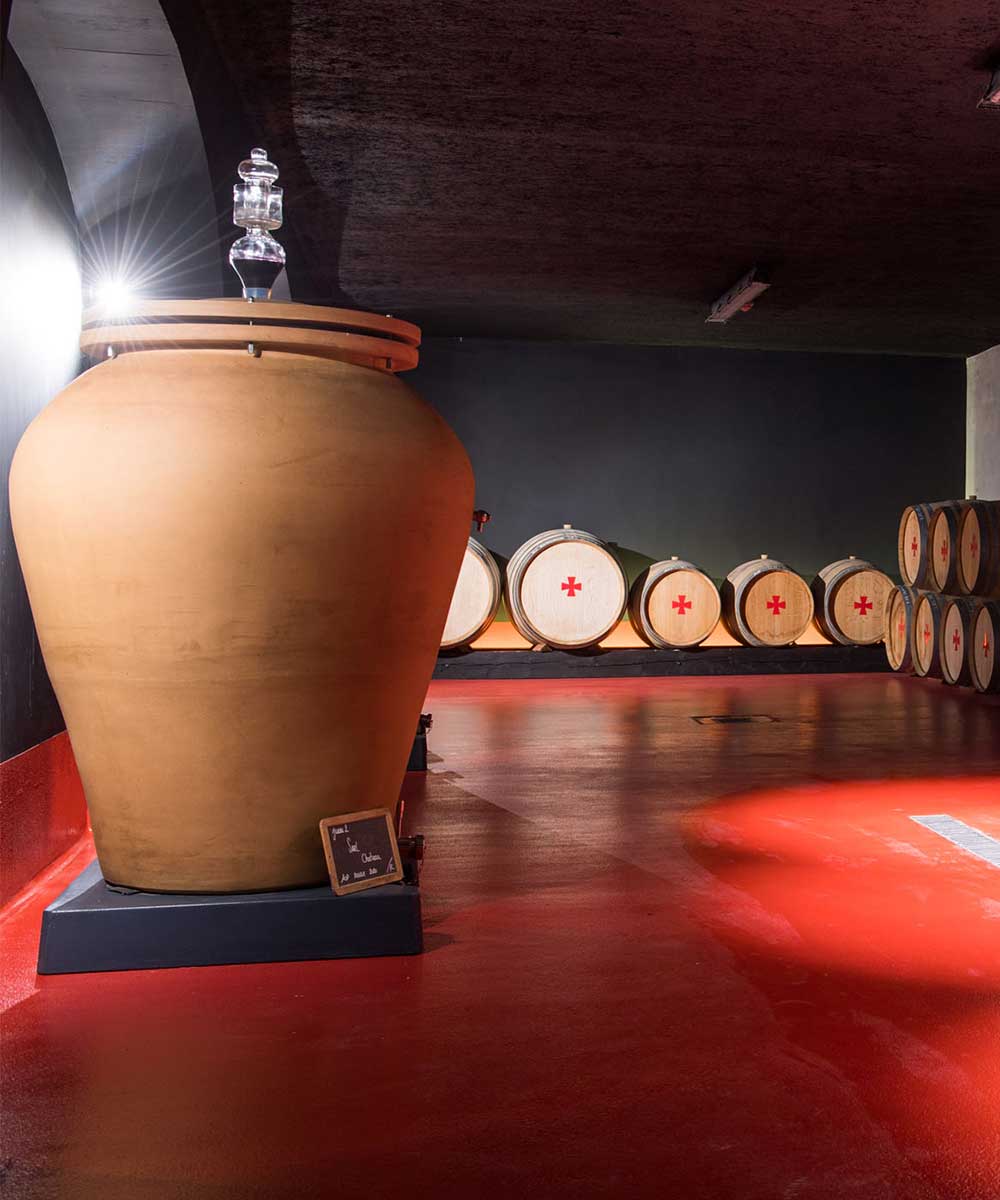
Our red wines
The vinification process for the Peyrassol reds is done with great precision. It combines the expression of the terroir and the freshness of the tannins.
The grapes, destemmed and sorted, land in concrete vats by gravity. The pulp (whole grapes – skins, pips, pulp) floats on the must (juice). The pulp contains the pigments, aromas and tannins that need to dissolve in the must during maceration.
As soon as must and pulp come into contact, they macerate. The grape juice then absorbs the tannins, colour, and some of the aromas from the pulp. Throughout the process (pre-fermentation, fermentation, and post-fermentation) maceration is encouraged by gently stirring (the must is brought to the surface to moisten the cap of the floating mass) and punching down (the cap is pushed into the must).
Alcoholic fermentation takes place by maintaining the vat temperature at around 25°C. At the end of the fermentation process, the vinification of Clos Peyrassol and Château Peyrassol vintages differs from that of Les Commandeurs, in that punching down is favoured rather than stirring, allowing for more intense extraction and maceration.
Unlike the rosés and whites, the pressing is carried out once fermentation is complete. The free-run wine runs off only after opening the bottom valve of the tank. The press juice is recovered after pressing the pomace which is still very wet. The proportion of free-run juice and pressed juice depends on the style of the desired wine.
Before bottling, the wines are finished in different containers suitable for their characteristics and to the desired style. And at Peyrassol the choice is vast: stainless steel vats, concrete vats, concrete egg-shaped vessels, stoneware jars, terracotta jars, oak barrels… the range available to the cellar master enables the preparation of wines that are both subtle and complex, celebrating their terroir and reflecting the passion of the men and women who create them.

Our rosés wines
How can we not start with the star of our cellars, the rosé. It is undoubtedly the estate’s largest production but certainly not the easiest. Because making a perfectly balanced rosé wine requires know-how, constant attention and, above all, a sense of timing!
But first we must clarify one point. The juice of red grapes is white. It consists of water, sugar, and acids. It is the skin that contains the colour, aromas, and tannins.
To make a rosé wine by direct pressing, the method used by Château Peyrassol, the grapes are placed in a pneumatic press and pressed for 2 to 4 hours. This is the only time when the juice is in contact with the skins. It then acquires its pinkish colour and aromas. The juice is then cleared of impurities: this is the settling process.
Then the alcoholic fermentation in stainless steel vats begins, at a temperature of between 15 and 18°C.
The juice of the grapes from the same plot is kept in dedicated and identified vats where vinification takes place until the time comes to blend the rosé and white wines.
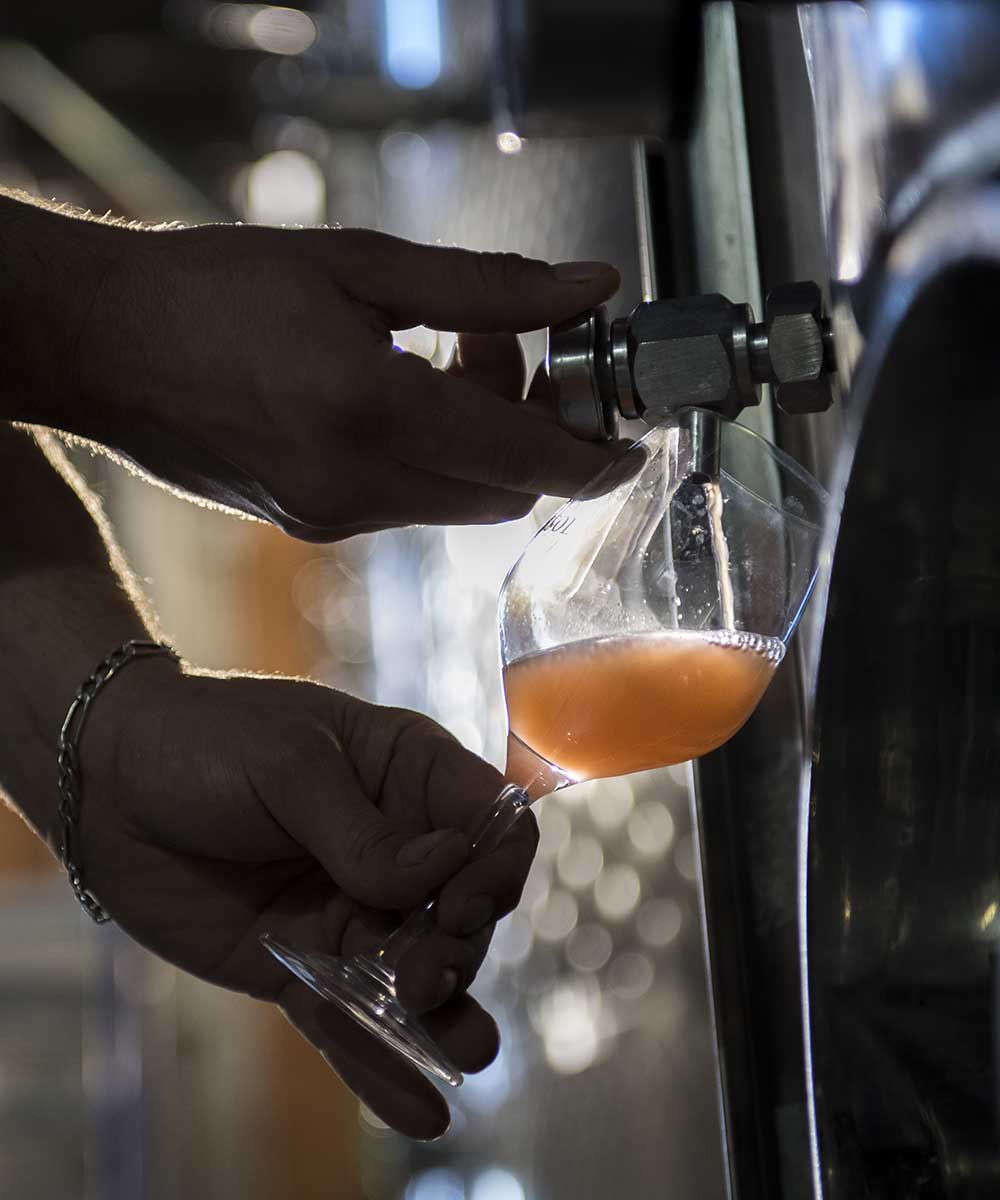

This is an essential step in Provence, which has made it a marker in the development of Côtes de Provence.
During tasting, each vat asserts its personality and characteristics. Like the nose required by a perfume designer, this palette of aromas, colours, olfactive and taste profiles is the scale on which the cellar master, surrounded by advisors and the owner, will use to create each cuvée.
Several stages and tasting sessions are necessary before obtaining the end result. Two pre-selection sessions in November, then 2 to 3 selection sessions before the final blend. Around the table, Fabien Burani and Pierre Guérin, our consultant for rosé and white wines over the past 20 years, and at times Fouad Essoualeh, the vineyard manager, with Alban Cacaret validate the final choice. It takes almost two months to complete this crucial stage, which also requires a combination of experience, intuition, and a touch of magic.
The rosés then age for a few months before being bottled from February onwards. Generally kept in stainless steel vats, they can also be vinified and then aged in jars, as is the case for the Clos Peyrassol.
Our white wines
Although they represent only 5% of the estate’s wines, the Peyrassol whites are not treated as a lesser wine. They are made exclusively with our white grape varieties and are therefore ‘Blancs de Blancs’ (whites made from white grapes). They are appreciated for their distinctive personality and finesse.
Before pressing, the grapes are separated from the stalks… but not always: for certain grape varieties, the “whole bunch” is pressed. This is a way of preserving the quality of the juice, protecting it as long as possible from coming into contact with the air by ensuring the grapes are intact until the very last moment.
A fundamental phase of white winemaking is the separation of the juice from the skins. Some grape skins are very aromatic: to get the best result from our grapes, we can leave the skins in contact with the juice for several hours at low temperature before pressing: this process is called maceration.
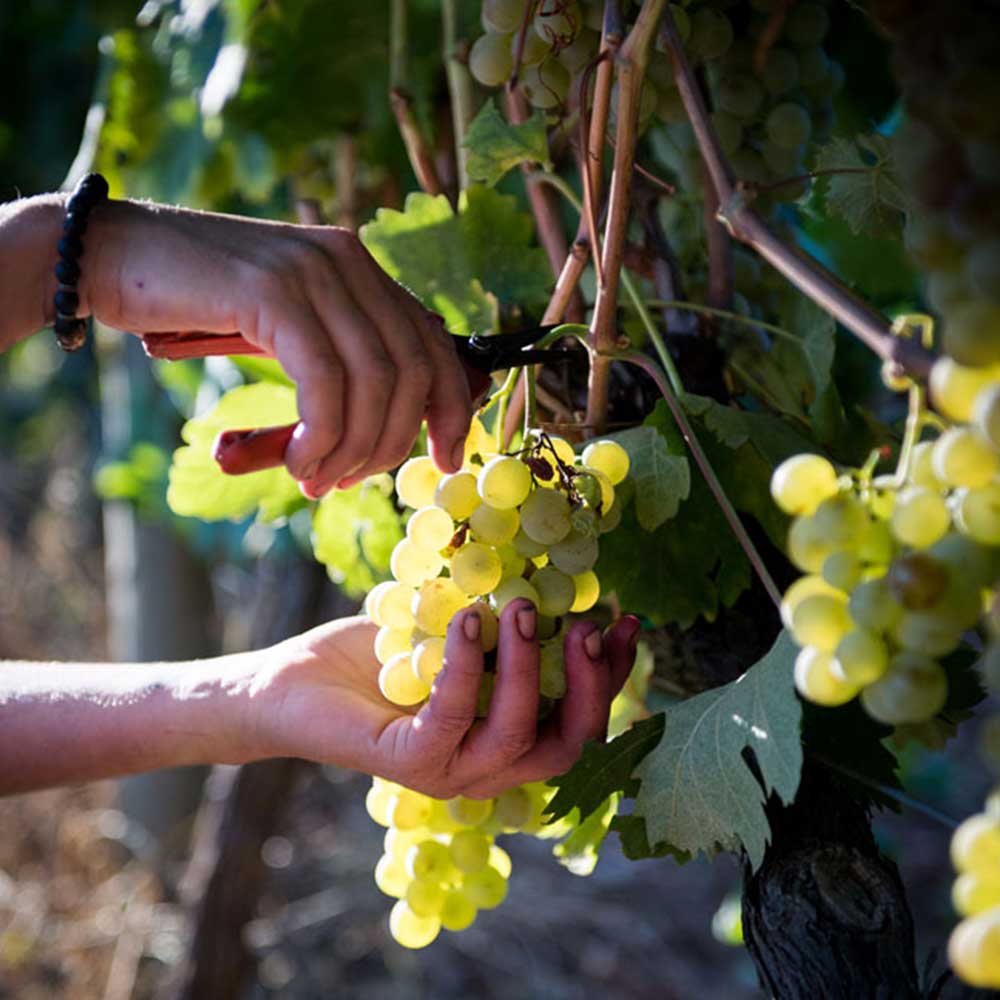

When the juice and skins have been separated, all the suspended particles are allowed to settle. The clearest part is transferred to another vat, to barrels or to stoneware jars. This process of clarification is called “débourbage”.
Once the juice in the new container is clear, the alcoholic fermentation takes place. The sugar turns into alcohol, the temperature rises during this transformation, and we keep the wine at a low temperature by using heat exchangers. Fermentation takes place between 14° and 18°C to preserve the quality of the aromas.
For a few months after fermentation, the new wine undergoes the ageing process: in stainless steel tanks, in oak barrels and/or, depending on the batch, in stoneware jars. Each container, because of the degree of exposure to air, will have a huge influence on the final taste of our different vintages.
Our red wines
The vinification process for the Peyrassol reds is done with great precision. It combines the expression of the terroir and the freshness of the tannins.
The grapes, destemmed and sorted, land in concrete vats by gravity. The pulp (whole grapes – skins, pips, pulp) floats on the must (juice). The pulp contains the pigments, aromas and tannins that need to dissolve in the must during maceration.
As soon as must and pulp come into contact, they macerate. The grape juice then absorbs the tannins, colour, and some of the aromas from the pulp. Throughout the process (pre-fermentation, fermentation, and post-fermentation) maceration is encouraged by gently stirring (the must is brought to the surface to moisten the cap of the floating mass) and punching down (the cap is pushed into the must).


Alcoholic fermentation takes place by maintaining the vat temperature at around 25°C. At the end of the fermentation process, the vinification of Clos Peyrassol and Château Peyrassol vintages differs from that of Les Commandeurs, in that punching down is favoured rather than stirring, allowing for more intense extraction and maceration.
Unlike the rosés and whites, the pressing is carried out once fermentation is complete. The free-run wine runs off only after opening the bottom valve of the tank. The press juice is recovered after pressing the pomace which is still very wet. The proportion of free-run juice and pressed juice depends on the style of the desired wine.
Before bottling, the wines are finished in different containers suitable for their characteristics and to the desired style. And at Peyrassol the choice is vast: stainless steel vats, concrete vats, concrete egg-shaped vessels, stoneware jars, terracotta jars, oak barrels… the range available to the cellar master enables the preparation of wines that are both subtle and complex, celebrating their terroir and reflecting the passion of the men and women who create them.